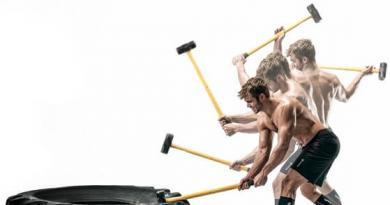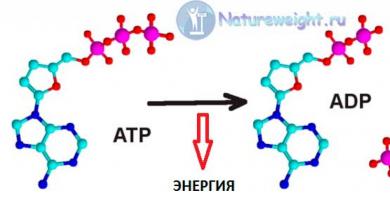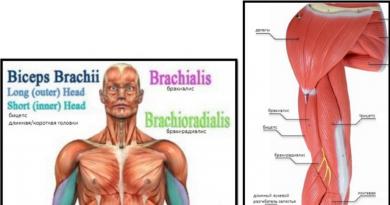Hello friends! Arm muscles: the anatomy of this muscle group is very interesting, and it will be useful for many to know it in order to understand where and how to direct their efforts in the training process.
Despite the fact that I am not a huge bodybuilder now (I am only 91-92 kg of “dirty” weight now), I have never really had problems with the formation of arm muscles.
They grew by themselves, honestly.
Well, it's not like I was lying upside down on the couch, and my hands were growing by themselves, no.
Simply, without doing anything special in the gym (the usual standard, illiterate workouts of 99% of beginners, such as “pull more, push further”), yes, and without eating anything supernatural, even in this situation, my hands didn’t look like thin twigs.
They somehow respond well to the load. With any training, at any intensity.
Later, when I began to closely study all the subtleties of the training process, physiology, human anatomy, then it became clear to me why this happened and is happening.
I will tell you all the very cool training tricks in the next article, about powerful arm training, and today we will focus on ANATOMY so as not to interfere with jelly with mashed potatoes, so to speak.
Arm muscles: anatomy
The muscles of the hands are divided into:
- Shoulder muscles.
- Muscles of the forearm.
The muscles of the SHOULDER, in turn, are divided into:
- Flexors (anterior group).
- Extensors (posterior group).
The FLEXIBLE group includes:
- Shoulder muscle.
- Biceps brachii.
- Coracobrachialis muscle.
The group of EXTENDERS includes:
- The triceps muscle of the shoulder (triceps).
- Elbow muscle.
We will not analyze the muscles of the forearm today, because. about them will be a separate, detailed article.
On the muscles of the shoulder, as we see, nothing complicated.
Let's take a look in a little more detail.
Muscles of the hands that we are most interested in
I never understood why focus on small muscle groups if the big ones are underdeveloped.
Why build a veranda when the house has not yet been built?
After all, training of large muscle groups gives a much greater release of anabolic hormones.
That is why the greatest interest for us among all the muscles of the hands will play only (in descending order of their size):
- Triceps (triceps muscle of the shoulder).
- Brachialis (shoulder muscle).
- a large "horseshoe" muscle of the arm, consisting of three heads.

From the outside, the triceps really look like a horseshoe.
- Long head triceps(internal) - attached to the back of the shoulder blade. Requires maximum abduction of the arm back (ideally, the shoulder joint should be additionally included in the work, since the long head is involved in its extension).
- Lateral head of the triceps + Medial head of the triceps- attached to the humerus. Participate only in EXTENSION OF THE FOREARM.
All three heads on the other side are attached in the area of the elbow joint, therefore, no matter what triceps exercise you use, you will always include ALL THREE HEADS in the work!
But the degree of involvement in the work of all heads will be different, depending on the mechanics of movements.
On the side of the elbow, there is also a tendon that unites and attaches ALL three bundles of the triceps to the bone. These are purely features of GENETICS, and training does not correct in any way.
- If you have it short, then the triceps are more “smeared” on the back of the arms, it turns out to be more massive.
- If your tendon is long, then the triceps is more PEAK, short.
There is a pattern (but not a rule!) if you:
- or mesomorph = triceps more massive, long.
- = triceps less massive, but more peaked, aesthetic.
Triceps Functions: extension of the forearm in the elbow joint (long, lateral and medial heads), extension of the shoulder and bringing it to the body (only the long head)
Biceps
Biceps(biceps brachii) - a large muscle, clearly visible on the front surface of the shoulder, consisting of two heads ("bi" \u003d two).

- long head(long tendon, but small part of the biceps): located on the outer part of the biceps.
- short head(short tendon, but most of the biceps): located on the inside of the arm.
Both heads of the biceps are attached to one tendon, which, in turn, attaches the biceps to the elbow joint. It's the same with triceps, remember?
But, since the ligament is attached to us not quite evenly (a little inward, to the side of the forearm), the biceps can not only bend the arm at the joint, but also SUPInate (turn) it towards the thumb.
With the development of the inner head of the biceps, no one has any special problems, because. it grows from almost any bending.
But the outer head lags behind the vast majority.
It so happened that anatomically the outer head is attached to the shoulder joint in the upper part, therefore, in order to involve it in the work, YOU NEED TO BRING THE ELBOWS BACK (which almost no one does). This will stretch it, purely from a mechanical point of view, and make it work.
There will be a lot of interesting chips in the next article about arm training, but for now let's dwell on these moments of the anatomy of the biceps.
Biceps Functions: flexion of the shoulder in the shoulder joint, flexion of the forearm in the elbow joint, supination (turn) of the forearm outwards.
Brachialis
Brachialis(shoulder muscle) - a muscle that is located UNDER the biceps (like a lining), but directly performs BENDING (does not participate in the process of turning the hand, because it is attached strictly evenly, and not on the side, like a biceps).
This is a very important point, it is the brachial muscle that allows you to pull “fart” weights in the gym in any bend, it is she who does 65-70% of the work, and not the biceps at all, as is commonly believed.
It is attached strictly exactly to the bone, and not to the side, like a biceps, so the vector of movement is concentrated on flexion in the elbow joint.
I will discuss in detail the features of brachialis training in the next article. It is very important to develop it, because this muscle, as it were, PUSHES the biceps outward (the more brachialis, the more the biceps sticks out).
Brachialis function: flexion of the forearm at the elbow joint.
That's all for today, my friends.
Soon there will be a cool article about arm training. There will be many cool chips and interesting features.
P.S. Subscribe to blog updates. It will only get worse from there.
With respect and best wishes, !



